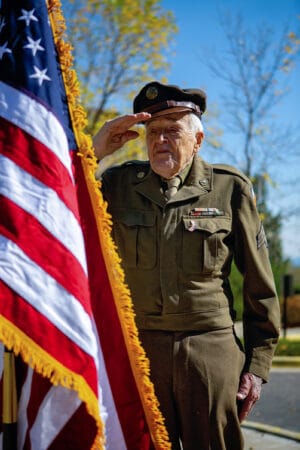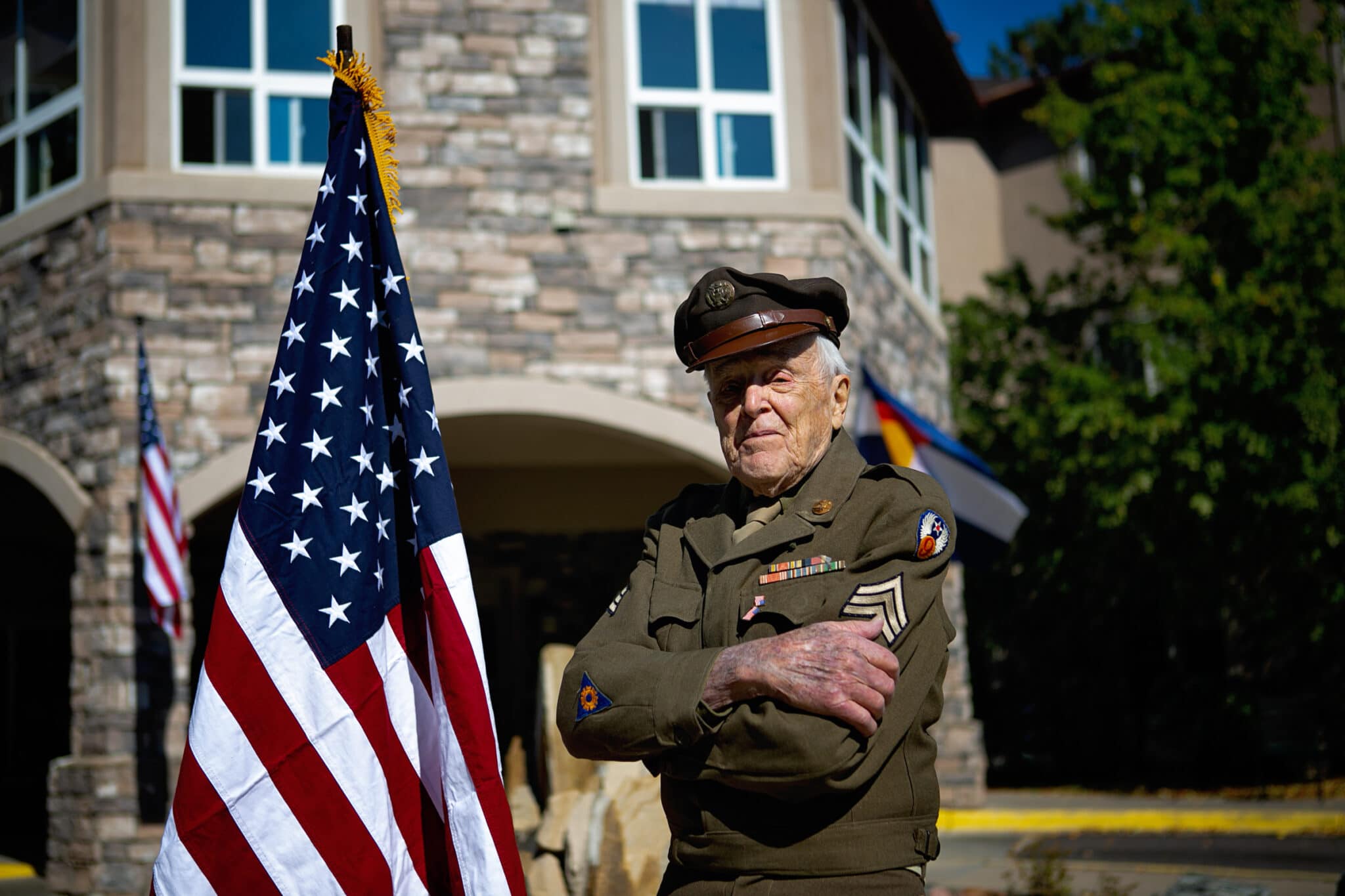A World War II Veteran’s Story
At Mount Evans, we fall in love easily. It happens every day with our patients. George Faust is no exception. The 94-year-old World War II veteran stole the hearts of everyone on his palliative care team in a matter of minutes. We had hoped to share his story with you in advance of Veterans Day. Although the day of recognition on November 11 is now behind us, we believe his service as well as all of the men and women throughout the mountain community who served our country should be recognized, remembered and acknowledged throughout the year. It’s why we participate in the We Honor Veterans program. We’ll talk more about that later, but first we want to share why we care so deeply about veterans and their care. George is the perfect example.
George Faust was in high school when World War II broke out. He was too young to serve his country when the Japanese attacked Pearl Harbor killing thousands. Instead, George would have to watch events unfold for two more years as he waited for his 18th birthday.
“I was still in high school,” George explains. “I still had half of my senior year left to finish, but I couldn’t wait. I wanted to be there. I felt I needed to serve so I enlisted in the Army.”
George’s greatest wish was to fly. Life and the Army had other plans for him.
“I didn’t get to do what I wanted to do,” says George. “I used to stammer a lot as a kid, I still do. During the interview, they had me read something and I stammered. They heard it and that was it.”
George never dwelled on what could have been, preferring instead to focus on what he could do, which turned out to be plenty. He found himself assigned to the Airborne Troops and responsible for maintaining gliders. With a year of training and service under his belt in the states, he set sail on the Queen Elizabeth for England in April 1945. From there, his unit made their way into France. George was lucky, he never saw combat. Within a month of his arrival, Germany surrendered, however, he did see the destruction it rendered on the landscape and in the men who survived.
“It was tough for those poor guys,” says George. “They suffered.”
With the war over and the long process of demobilization beginning, George soon found himself being utilized in new ways when a supervisor asked him if he could drive a dump truck.
“I told him yes, but I had never driven one in my life. I had to get in there and figure out where the gear shift was at and how to use it.”
After five days behind the wheel of dump truck, he was asked if he could drive a semi-truck. It had a 26-foot trailer on the back of it and of course George had never driven one, but again, George said yes.
“Being in the service gave me a little bit better feeling about myself.” George explains, “I did things that I had never done before. It was an important part of my life. It gave me self-confidence.”

George proudly wears the uniform he was issued in 1944. It still fits after 76 years and much like the man who wears it, it still has a story to tell and it’s still going strong. When asked about the 26 months he served in the Army, George likes to say that he experienced the best of the good stuff.
“It was an honor to go into the service and do what I could. I learned so many things and I got to see the big, beautiful city of Paris with the Notre Dame Cathedral, the Champs-Élysées and the Arc de Triomphe. I made the best use of it that I could.”
Before George left for the war, he had his eye on a girl from his hometown in Chicago. While he was stationed in France, he received a letter and a picture from her little sister Eleanor, a thin little girl he had never paid much attention to. That letter was the beginning of his future. George likes to joke that his wife won out, because he came back from the war and married Eleanor. They spent their honeymoon in Colorado and have a picture in front of the Evergreen Dam. George decided that one day he was going to live here. It took almost a lifetime for him to make good on that promise, but we’re glad he did because it is our honor to care for George.

Of the 16 million Americans who served in World War II, only 325,574 are still are alive in 2020 according to the US Department of Veterans Affairs. This statistic was calculated before the COVID-19 pandemic. At Mount Evans we are committed to providing veterans from every branch of the military and from every conflict with the highest quality care, comfort and support.
“Each vet has had such a varied experience in the military. It’s important to understand whether they were drafted or enlisted, male or female, served in combat, behind the scenes or peacetime,” says Mary Noonan, a social worker at Mount Evans leading the We Honor Veterans program. “It’s not unusual for those who have experienced trauma to have physical and psychological symptoms at end of life. The We Honor Veterans program provides our staff and volunteers with the education and tools to assist people to a peaceful, comfortable passing.”




